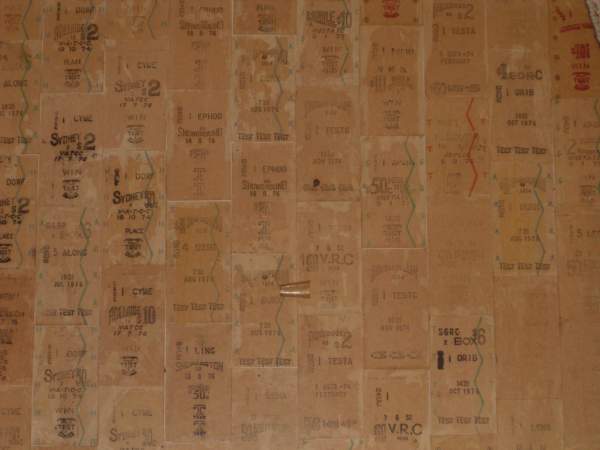Totalisator History Secondly Section

| Introduction to Secondly |

| Introduction to Secondly |
I sometimes question my continued interest in this subject however there are times when the efforts of someone else are an inspiration. I learnt that Professor Bromley from Sydney University had stored two thirds of the Broadmeadows totalisator system in his house! I believe that The Hunter Regional Museum has the rest of this system on display.
Since the first release of these pages a year ago I have concluded that relating the history of this company has a greater significance than just recording its early technological achievements. As we approach the threshold of the third millennium, few in the work force will not have seen the impact of downsizing. The predictions seem to be of smaller companies or individuals glued together with information technology into networked organisations. This may eventually lead to the demise of the whole genre of company structure that this company represents. If this is the case I hope that this history, with some additional work, will become somewhat of a record of the nature of these once common, larger than 1000 employee companies.
One last paragraph on those technological achievements. I have often thought of attempting to specify the historical significance of these old electro mechanical systems. What can be said about an electro mechanical system that looks like a network and has selling terminals long before electronic computers were thought of? I have been reluctant to write anything along these lines as I am obviously biased. I do however note that the Computer Conservation Society, a specialist group of the British Computer Society have published on the web that these systems are considered to be Large-scale, multi-terminal, real-time computers. A link to The Computer Conservation Society can be found in the links to other related pages section.
I read an article in a human resource journal once titled The death of the corporate citizen and I realised that I was a corporate citizen, probably along with many of my generation. I am not going to provide a definition of a corporate citizen, however I suspect that anyone who has been in a work environment where they felt part of something much larger than themselves with a sense of belonging will probably know what it means. Here too we are looking at the potential loss of a whole way of working life. It is my intention that eventually these pages will provide some insight into life inside these companies.
I have worked for three Australian technology companies, AWA (Amalgamated Wireless Australasia), United Telecasters (Channel 10) and ATL (Automatic Totalisators Limited). There were many features of these workplaces which were characteristic of an era. Many of these have disappeared, possibly forever. Some of these were Typing Pools, Drawing Offices, Test Rooms, Print Rooms, Canteens, Company Libraries, Assembly Lines, Machine Shops, Parts Stores, Personnel Departments and Packing Sections. I have discussed these with others of my generation and found that they feature prominently in their memories also. This section provides a record of most of these departments.
Memories of the factory is a transcription of an audio tape sent to me by Neville Mitchell. He recalls the Meadowbank factory and relates to many of the departments mentioned above. He has 32 years experience in the tote industry. There are some very interesting photographs of the factory copied from a photograph album Neville lent me.
Tote Topics was the company's quarterly magazine. I have included extracts from this and other company magazines in this section. The extracts relate to a few of the company's Race Club customers. The race tracks were the domain of the installation, sales and operations departments. As computer systems were introduced, programmers became involved in this domain as well.
I received email from Kentucky requesting information on the early American history. I have acquired some information which I have presented in this section.
I have also included a photo gallery of photos I received from Frank Matthews relating to the early history of Automatic Totalisators.
Back to the subject of the efforts of others. Interest in this history manifests itself in very diverse ways. Don McKenzie who spent a quarter of a century working on the totalisators in Victoria came up with a novel idea. He wallpapered a room in his house with tote tickets. He recently had his house painted and contemplated removing the tickets. After 30 years with these walls, he could not bring himself to do it. The tickets come from J6 J8 J10 J22 and J25 ticket issuing machines. Fred Accar wrote to me from New York indicating that he was a collector of tote tickets. I put him in contact with Don and after Don sent him the following image Fred wrote WOW, That is the best damned wall I have ever seen!!!! You people are my kinda people. Thanks so much for responding and sharing that wonderful "Tote" wall of yours. Truly a classic it belongs in the "Luv" ...
There is a link to Don's company website Dontronics in the links page accessible from the index.
 Don's tote ticket wallpaper.
Don's tote ticket wallpaper.
![]()
| Acknowledgements |
Comments and suggestions welcome to
totehis@hotmail.com 
| Previous page | Go to the index | Top of the page | Next page |